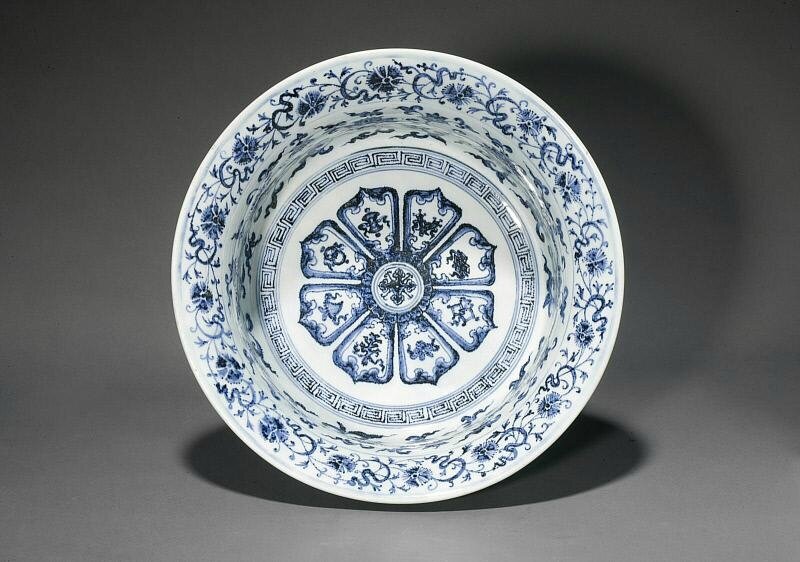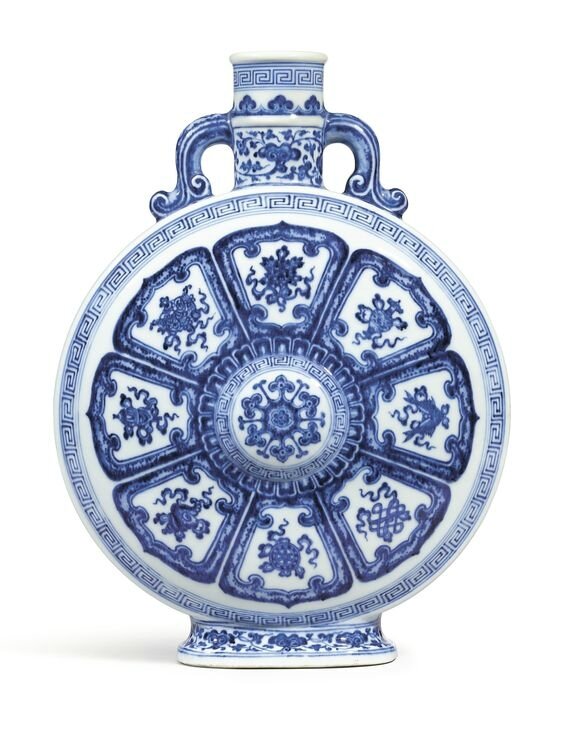A blue and white 'Bajixiang' moonflask, seal mark and period of Qianlong
Lot 3688. A blue and white 'Bajixiang' moonflask, seal mark and period of Qianlong (1736-1795), 34.5 cm, 13 5/8 in. Estimate 600,000 — 800,000 HKD. Lot sold 937,500 HKD. Photo: Sotheby's.
the circular body rising from a splayed oval foot to a cylindrical neck flanked by a pair of S-scroll handles, finely painted in varying tones of cobalt blue enhanced by simulated 'heaping and piling', each side centred on a large boss with a floral medallion comprising ruyi-shaped petals enclosed within a key-fret and lappet border, all encircled by radiating bold lotus petal panels containing the bajixiang, surrounded by a key-fret border, the flat sides with a narrow band of leafy scrolls issuing lotus blooms, the neck and foot each painted with a lingzhi scroll and key-fret around the rim, inscribed on the base with a six-character seal mark.
Provenance: A Japanese private collection, formed in the 1930s.
Sotheby's Paris, 12th December 2013, lot 144.
Note: In both its form and painted motif, as well as its simulation of the 'heaped and piled' technique to render the design, this moonflask immediately references China’s glorious porcelain tradition. The flattened form with raised medallion is modelled after early fifteenth century flasks, that were in turn inspired Middle-Eastern metal prototypes, while the design is reminiscent of an early-Ming Buddhist motif of a double vajra surrounded by eight petal panels containing the bajixiang. Interestingly, in the Qing version the order of the bajixiang has been slightly altered, with the twin-fish emblem appearing before the knot and after the vase emblem.
While flasks of this type are numerous, the present piece is particularly unusual for its size, the form of its handles and the raised rib on the neck; similar examples include one sold in our London rooms, 13th May 1969, lot 137; another from the Manno Art Museum, sold at Christie’s London, 21st June 2001, lot 106; and a third sold at Christie’s New York, 16th September 2011, lot 1547. Compare also larger flasks of related form and design, such as one in the National Palace Museum, Taipei, included in the Illustrated Catalogue of Ch’ing Dynasty Porcelain in the National Palace Museum, vol. II, Tokyo, 1981, pl. 5; two published in Chinese Ceramics in the Idemitsu Collection, Tokyo, 1987, pls 949 and 950, the latter lacking the Qianlong reign mark; and another in the Nanjing Museum, Nanjing, illustrated in Zhongguo lidai Jingdezhen ciqi: Qing juan [Chinese ceramics from Jingdezhen through the ages: Qing dynasty], Beijing, 1998, p. 169.
For the prototype of this motif, see a blue and white basin attributed to the Yongle reign, in the Asian Art Museum, San Francisco, illustrated in He Li, Chinese Ceramics: A New Comprehensive Survey from the Asian Art Museum of San Francisco, New York, 1996, pl. 398.

Blue and white Buddhist ablution basin with Eight Treasures, dynasty (1368-1644), Reign of the Yongle Emperor (1403-1424), The Avery Brundage collection, B60P33+, Asian Art Museum of San Francisco. Image courtesy of the Asian Art Museum, San Francisco
Sotheby's. Important Chinese Art, Hong Kong, 03 Oct 2017

/https%3A%2F%2Fprofilepics.canalblog.com%2Fprofilepics%2F1%2F0%2F100183.jpg)
/https%3A%2F%2Fstorage.canalblog.com%2F03%2F02%2F119589%2F96711876_o.jpg)
/https%3A%2F%2Fstorage.canalblog.com%2F11%2F31%2F119589%2F94773502_o.jpg)
/https%3A%2F%2Fstorage.canalblog.com%2F20%2F83%2F119589%2F94772815_o.jpg)
/https%3A%2F%2Fstorage.canalblog.com%2F26%2F72%2F119589%2F75604929_o.jpg)
/https%3A%2F%2Fstorage.canalblog.com%2F59%2F60%2F119589%2F26458628_o.jpg)





/image%2F1371349%2F20240416%2Fob_2a8420_437713933-1652609748842371-16764302136.jpg)
/image%2F1371349%2F20240414%2Fob_83ee65_2024-nyr-22642-0954-000-a-blue-and-whi.jpg)
/image%2F1371349%2F20240414%2Fob_15808c_2024-nyr-22642-0953-000-a-blue-and-whi.jpg)
/image%2F1371349%2F20240414%2Fob_e54295_2024-nyr-22642-0952-000-a-rare-blue-an.jpg)